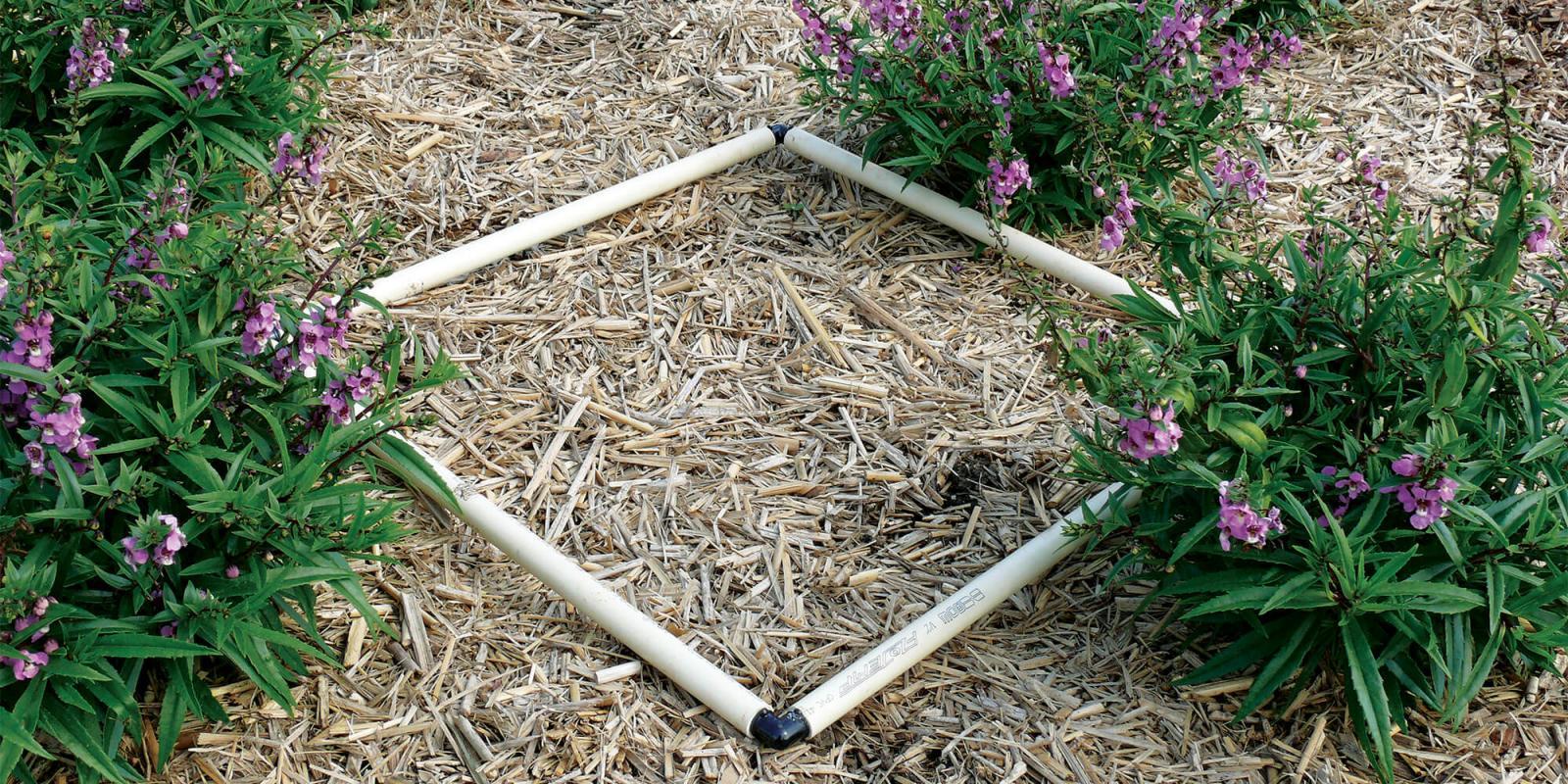January 1, 2016

Weed counts were taken inside this quadrant; weeds were pulled out after the counts were taken. Photo shows angelonia plants and chopped miscanthus mulch.
Some new faces for mulch
New mulch alternatives for landscape applications
BY PATRICK HUBER-KIDBY
Landscaping is a never-ending battle against weeds, and new management tools are always of interest to Home owners, Businesses, and Landscaping Professionals. Wood bark is the commonly used mulch for landscape gardens.
This past summer at the Guelph Turfgrass Institute (GTI) (Guelph, Ont.) and at Landscape Ontario, (Milton, Ont.), a preliminary study was carried out with different mulches on garden beds plants in small demonstration plots.
Beginning in late June 2015 at the GTI, five different types of mulch were applied to garden plots in an area just over two square metres. These plots, containing six Angelonia (A. angustifolia) each, were replicated in three different locations at the site.
The trial examined the emergence of new weeds each week, beginning one week after the mulches were applied. Three sample areas of 0.15 m² were randomly selected using a quadrant and weed counts were taken, and removed each week. The data generated was analyzed to quantify for weed suppression effectiveness per dollar.
Methods
The five mulches studied include:Bark Mulch: Shredded pine mulch was applied at 15 litres per square metre
Composted Sawdust used was from the University of Guelph’s horse barns and is composed of sawdust and animal waste. It was applied at 14 litres per square metre.
Chopped Miscanthus was one of two purpose- grown biomass crops that were tested in this trial. It is a perennial grass currently being looked at for livestock bedding, and as an alternative to petroleum based commodities including energy, chemicals and biologically derived materials for a host of applications. The miscanthus mulch was chopped to 2 to 3 inches in length was applied at 20 litres per square metre.
Switchgrass Pellets: Switchgrass is another purpose grown biomass crop, with similar potentials uses as Miscanthus. Pelleted switchgrass (finely chopped switchgrass that is then compressed and heated) have been developed for heating applications, just like wood pellets. The switchgrass pellets were applied at 14 litres per square metre. When irrigated, the switchgrass pellets expanded to 3 to 4 times their dry volume, creating a much thicker layer of mulch.
Liquid Polymer Mulch: From Advanced Micro Polymers (AMP), this mulch is a liquid formulation comprised of organic materials that solidify upon drying. It was applied at two kilograms per square metre with a small piston pump but can just as easily be applied in smaller quantities by watering can.
Findings
Switchgrass pellets were the most effective mulch per cost and efficacy for weed suppression, letting through 0.06 weeds/m²/$ when applied at 14 litres per square metre, followed by the chopped Miscanthus at 0.87 weeds/m²/$. The switchgrass pellets performance is likely related to its expanding properties and longevity (it takes an extra year to break down). As dry pellets, switchgrass pellets were comparable in quantity to the other mulch applications but swiftly expanded to 3-4 times the volume, giving 3-4 times the barrier for weeds to contend with.During this trial other factors such as plant health were observed and measured however there was such variability amongst health and vigour of the Angelonia that no conclusions could be reached. None of the mulches had obvious positive or negative effects.
This trial was conducted over a three month period and during that time yielded some valuable data, but more research is necessary to replicate our results. The mulches efficiency will continue to be monitored at the plots, and their transitions from winter to next spring will be closely monitored; especially for their physical qualities and level of degradation.
The author wishes to acknowledge, OMAFRA for the summer job and the project team, Mahendra Thimmanagari and Jennifer Llewellyn (OMAFRA); Rodger Tschanz, University of Guelph; Gildale Farms, St. Mary’s; Forman Farms, Seeley’s Bay; Switch Energy Corp, Clinton; All Weather Farming, Simcoe; Advanced Micro Polymers, Milton; Gro-Bark, Milton for providing mulch samples for the trials.
For more information, contact: Mahendra Thimmanagari, Crop Bioproducts Specialist, Ontario Ministry of Agriculture, Food and Rural Affairs (OMAFRA), 519-826-4593. mahendra.thimmanagari@ontario.ca